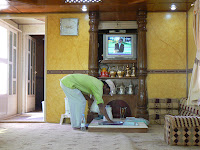 We finally started our mission inside Iraq. Kuwait is interesting, of course, but after six months many of us were sick of being restricted to the border and eventless regions of Kuwait. Of course, we were in the desert part of Basra province the entire time, so the landscape was very similar to that of northern Kuwait – just a little more arid and with fewer, poorer people who tend their own livestock instead of hiring south Asians to do it for them. Most of the people we see are either Bedouin herders, or oil workers. At times we only see a single vehicle in an entire hour. This old Iraqi man was stopped at one of our traffic control points, and I gave him a bottle of water.
We finally started our mission inside Iraq. Kuwait is interesting, of course, but after six months many of us were sick of being restricted to the border and eventless regions of Kuwait. Of course, we were in the desert part of Basra province the entire time, so the landscape was very similar to that of northern Kuwait – just a little more arid and with fewer, poorer people who tend their own livestock instead of hiring south Asians to do it for them. Most of the people we see are either Bedouin herders, or oil workers. At times we only see a single vehicle in an entire hour. This old Iraqi man was stopped at one of our traffic control points, and I gave him a bottle of water.The most interesting birds were the raptors: I saw a pallid harrier, some black kites, an unidentified eagle, a buzzard that was probably a long-legged buzzard, two unidentified eagles, a marsh harrier, a few kestrels, and one saker falcon. Otherwise the area was largely devoid of bird life. There are beetles, long-legged ants that make long trails on the surface of the desert, and tiny plants. Most of the plants in the driest parts of the desert are species that are common in more fertile areas, except their growth is stunted so that they only reac
 h a size of about two inches in diameter. For example, the plantain and composite flower in this picture are normally about ten inches high in most parts of Kuwait. Other common dwarf plants are three centimeter high Neurada Procumbens, and four centimeter high Haloxylon salicornicum (which is the dominant shrub in northern Kuwait).
h a size of about two inches in diameter. For example, the plantain and composite flower in this picture are normally about ten inches high in most parts of Kuwait. Other common dwarf plants are three centimeter high Neurada Procumbens, and four centimeter high Haloxylon salicornicum (which is the dominant shrub in northern Kuwait)..JPG) We were visited by some high-ranking officers, who were dropped off and picked up at one of our traffic control points by a UH-60 blackhawk helicopter. Our element must have looked rather bizarre from the air: a few heavily armed trucks and soldiers shutting down a small desert road, even though there seems to be no one around. We did get some interesting comments from a senior officer, who mentioned the possibility of a withdrawal mandated by Washington, the tenuous nature of our relationships with the Kuwaiti and Iraqi governments, and other long-term, large-scale concerns. Although such news are always in the media, I cannot really get myself to believe that they are more than empty threats, criticisms and rumors. The sheer scale of the US military apparatus in the Iraqi theater makes any end to this campaign seem like a dim prospect at best. In fact, when I see congressional timelines for troop pullout I cannot help but think of the staggering amount of materiel we would have to abandon there because there weren’t enough containers, planes, trucks, aircraft and ships available.
We were visited by some high-ranking officers, who were dropped off and picked up at one of our traffic control points by a UH-60 blackhawk helicopter. Our element must have looked rather bizarre from the air: a few heavily armed trucks and soldiers shutting down a small desert road, even though there seems to be no one around. We did get some interesting comments from a senior officer, who mentioned the possibility of a withdrawal mandated by Washington, the tenuous nature of our relationships with the Kuwaiti and Iraqi governments, and other long-term, large-scale concerns. Although such news are always in the media, I cannot really get myself to believe that they are more than empty threats, criticisms and rumors. The sheer scale of the US military apparatus in the Iraqi theater makes any end to this campaign seem like a dim prospect at best. In fact, when I see congressional timelines for troop pullout I cannot help but think of the staggering amount of materiel we would have to abandon there because there weren’t enough containers, planes, trucks, aircraft and ships available.This blog’s quote is really just a word that I liked. According to the magazine The Economist of April 14, Arab political dissenters who spread their views through blogs call themselves “pyjamahideen.”
.JPG)
.JPG)
.JPG)
.JPG)
.JPG)
.JPG)

.JPG)
